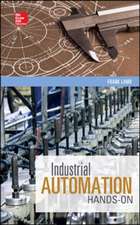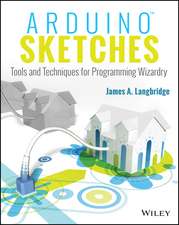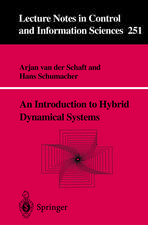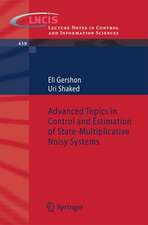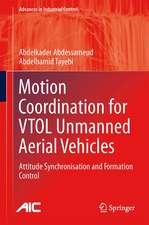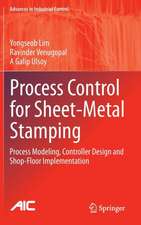Case Studies in Control: Putting Theory to Work: Advances in Industrial Control
Editat de Stanko Strmčnik, Đani Juričićen Limba Engleză Hardback – iul 2013
Following the illustrations of the progress that can be made from either extreme of the well-known theory–practice divide, the text proceeds to a third part related to the development of tools that enable simpler use of advanced methods, a need only partially met by available commercial products.
Each case study represents a self-contained unit that shows an experimental application of a particular method, a practical solution to an industrial problem or a toolkit that makes control design and implementation easier or more efficient. Among the applications presented are:
- wastewater treatment;
- manufacturing of electrical motors ;
- temperature control of blow moulding;
- burn-protective garments quality assessment; and rapid prototyping.
Advances in Industrial Control aims to report and encourage the transfer of technology in control engineering. The rapid development of control technology has an impact on all areas of the control discipline. The series offers an opportunity for researchers to present an extended exposition of new work in all aspects of industrial control.
| Toate formatele și edițiile | Preț | Express |
|---|---|---|
| Paperback (1) | 950.66 lei 6-8 săpt. | |
| SPRINGER LONDON – 16 iul 2015 | 950.66 lei 6-8 săpt. | |
| Hardback (1) | 951.29 lei 6-8 săpt. | |
| SPRINGER LONDON – iul 2013 | 951.29 lei 6-8 săpt. |
Din seria Advances in Industrial Control
- 15%
 Preț: 643.34 lei
Preț: 643.34 lei - 23%
 Preț: 582.63 lei
Preț: 582.63 lei - 18%
 Preț: 783.98 lei
Preț: 783.98 lei - 18%
 Preț: 947.35 lei
Preț: 947.35 lei - 20%
 Preț: 568.24 lei
Preț: 568.24 lei - 15%
 Preț: 643.16 lei
Preț: 643.16 lei - 18%
 Preț: 899.21 lei
Preț: 899.21 lei - 18%
 Preț: 891.33 lei
Preț: 891.33 lei - 18%
 Preț: 740.57 lei
Preț: 740.57 lei - 18%
 Preț: 961.23 lei
Preț: 961.23 lei - 18%
 Preț: 955.08 lei
Preț: 955.08 lei - 15%
 Preț: 645.28 lei
Preț: 645.28 lei - 15%
 Preț: 638.43 lei
Preț: 638.43 lei - 18%
 Preț: 901.11 lei
Preț: 901.11 lei - 18%
 Preț: 1410.94 lei
Preț: 1410.94 lei - 18%
 Preț: 728.91 lei
Preț: 728.91 lei - 20%
 Preț: 1003.77 lei
Preț: 1003.77 lei - 18%
 Preț: 947.35 lei
Preț: 947.35 lei - 15%
 Preț: 643.34 lei
Preț: 643.34 lei - 15%
 Preț: 654.30 lei
Preț: 654.30 lei - 18%
 Preț: 950.52 lei
Preț: 950.52 lei - 15%
 Preț: 644.30 lei
Preț: 644.30 lei - 18%
 Preț: 1393.09 lei
Preț: 1393.09 lei - 18%
 Preț: 950.21 lei
Preț: 950.21 lei - 18%
 Preț: 949.90 lei
Preț: 949.90 lei - 18%
 Preț: 949.42 lei
Preț: 949.42 lei - 18%
 Preț: 950.52 lei
Preț: 950.52 lei - 18%
 Preț: 1113.71 lei
Preț: 1113.71 lei - 15%
 Preț: 650.04 lei
Preț: 650.04 lei - 15%
 Preț: 644.95 lei
Preț: 644.95 lei - 18%
 Preț: 950.33 lei
Preț: 950.33 lei - 18%
 Preț: 948.61 lei
Preț: 948.61 lei - 18%
 Preț: 1112.60 lei
Preț: 1112.60 lei - 15%
 Preț: 644.63 lei
Preț: 644.63 lei - 18%
 Preț: 953.20 lei
Preț: 953.20 lei - 18%
 Preț: 945.62 lei
Preț: 945.62 lei - 15%
 Preț: 640.88 lei
Preț: 640.88 lei - 15%
 Preț: 640.88 lei
Preț: 640.88 lei - 20%
 Preț: 650.92 lei
Preț: 650.92 lei - 18%
 Preț: 1112.60 lei
Preț: 1112.60 lei - 20%
 Preț: 998.36 lei
Preț: 998.36 lei - 15%
 Preț: 643.34 lei
Preț: 643.34 lei - 18%
 Preț: 948.92 lei
Preț: 948.92 lei - 18%
 Preț: 1381.43 lei
Preț: 1381.43 lei - 15%
 Preț: 651.51 lei
Preț: 651.51 lei - 15%
 Preț: 647.08 lei
Preț: 647.08 lei - 20%
 Preț: 563.66 lei
Preț: 563.66 lei - 18%
 Preț: 998.03 lei
Preț: 998.03 lei - 18%
 Preț: 1225.79 lei
Preț: 1225.79 lei
Preț: 951.29 lei
Preț vechi: 1160.10 lei
-18% Nou
Puncte Express: 1427
Preț estimativ în valută:
182.08€ • 189.37$ • 152.58£
182.08€ • 189.37$ • 152.58£
Carte tipărită la comandă
Livrare economică 13-27 martie
Preluare comenzi: 021 569.72.76
Specificații
ISBN-13: 9781447151753
ISBN-10: 1447151755
Pagini: 441
Ilustrații: XVI, 411 p. 224 illus., 112 illus. in color.
Dimensiuni: 155 x 235 x 25 mm
Greutate: 0.61 kg
Ediția:2013
Editura: SPRINGER LONDON
Colecția Springer
Seria Advances in Industrial Control
Locul publicării:London, United Kingdom
ISBN-10: 1447151755
Pagini: 441
Ilustrații: XVI, 411 p. 224 illus., 112 illus. in color.
Dimensiuni: 155 x 235 x 25 mm
Greutate: 0.61 kg
Ediția:2013
Editura: SPRINGER LONDON
Colecția Springer
Seria Advances in Industrial Control
Locul publicării:London, United Kingdom
Public țintă
Professional/practitionerCuprins
About the Gap between Theory and Practice.- Part I: From Theory towards Practice.- Identification and Control Using Piece-wise Hammerstein Models.- Tracking Explicit Model Predictive Controllers for Low-level Control Applications.- Divide-and-conquer Method for Analysis and Control of Nonlinear Systems.- Model-based Control of Nitrogen-removal Processes in a Wastewater-treatment Plant.- Part II: From Practice towards Theory.- Temperature Control in a Plastic Extruder Control System.- Tension Control in a Steel-slitting Line.- Final Quality Assessment in the Manufacturing of Electrical Motors.- Model-based Estimation of Burn Injuries.- Part III: Tools and Building Blocks for Control Systems Implementation.- A PLC-based System for Advanced Control.- An Approach to Control Systems SW Development.
Notă biografică
Stanko Strmčnik joined the Jožef Stefan Institute, the leading Slovenian research institute in the field of natural sciences and engineering, in 1973. Since 1986 he has been head of the Department of Computer Automation and Control (later renamed the Department of Systems and Control) at the same institute. He is also a professor at the Faculty of Electrical Engineering, University of Ljubljana and at the School of Engineering and Management, University of Nova Gorica. During his career he has been involved in numerous research-and-development projects as well as various industrial applications. His research interests involve mathematical modelling, identification, optimal control, predictive control, PID tuning, process control, non-technical aspects of automation and technology transfer. He initiated and led the development of various tools and building blocks for control system implementation, e.g., SIMER – a microcomputer-based data-acquisition and control system, ANA – a universal computer-aided control systems design tool, MMC-90 – a microprocessor multi-loop controller, and ASPECT – a PLC-based system for advanced control. He was also deeply involved in some large industrial engineering projects, among them combustion control in boilers and industrial furnaces, the computer control of pulp cooking, and the computer control of titanium dioxide production.
Đani Juričić is a research fellow at the Jožef Stefan Institute and a professor of electrical engineering at the University of Nova Gorica. For almost 30 years he has been active in applied research in automatic control through numerous research grants and projects for industry, in the majority of which he acted as project leader. His research interests include condition monitoring, fault detection, isolation and prediction, the mathematical modelling of dynamical processes, signal processing, system identification, PID and optimal controller design. He has contributed to the CACSDtool ANA, algorithms for the control design of systems with backlash, the control of Wiener systems, PID tuning, modelling for the purpose of control, validation of data-driven models, algorithms for robust control and fault detection, and novel fault-localisation approaches based on approximate reasoning. His notable industrial accomplishments include algorithms for the on-line, model-based control of a pulp cooking process, condition monitoring systems for several processes in the chemical and process industries, a prototype of a system for fault detection and isolation in the production of electrical motors and a system for the on-line supervision of rotational machines and drives.
Đani Juričić is a research fellow at the Jožef Stefan Institute and a professor of electrical engineering at the University of Nova Gorica. For almost 30 years he has been active in applied research in automatic control through numerous research grants and projects for industry, in the majority of which he acted as project leader. His research interests include condition monitoring, fault detection, isolation and prediction, the mathematical modelling of dynamical processes, signal processing, system identification, PID and optimal controller design. He has contributed to the CACSDtool ANA, algorithms for the control design of systems with backlash, the control of Wiener systems, PID tuning, modelling for the purpose of control, validation of data-driven models, algorithms for robust control and fault detection, and novel fault-localisation approaches based on approximate reasoning. His notable industrial accomplishments include algorithms for the on-line, model-based control of a pulp cooking process, condition monitoring systems for several processes in the chemical and process industries, a prototype of a system for fault detection and isolation in the production of electrical motors and a system for the on-line supervision of rotational machines and drives.
Textul de pe ultima copertă
Case Studies in Control presents a framework to facilitate the use of advanced control concepts in real systems based on two decades of research and over 150 successful applications for industrial end-users from various backgrounds. In successive parts the text approaches the problem of putting the theory to work from both ends, theoretical and practical. The first part begins with a stress on solid control theory and the shaping of that theory to solve particular instances of practical problems. It emphasizes the need to establish by experiment whether a model-derived solution will perform properly in reality. The second part focuses on real industrial applications based on the needs and requirements of end-users. Here, the engineering approach is dominant but with theoretical input of varying degree depending on the particular process involved.
Following the illustrations of the progress that can be made from either extreme of the well-known theory–practice divide, the text proceeds to a third part related to the development of tools that enable simpler use of advanced methods, a need only partially met by available commercial products.
Each case study represents a self-contained unit that shows an experimental application of a particular method, a practical solution to an industrial problem or a toolkit that makes control design and implementation easier or more efficient. Among the applications presented are:
Advances in Industrial Control aims to report and encourage the transfer of technology in control engineering. The rapid development of control technology has an impact on all areas of the control discipline. The series offers an opportunity for researchers to present an extended exposition of new work in all aspects of industrial control.
Following the illustrations of the progress that can be made from either extreme of the well-known theory–practice divide, the text proceeds to a third part related to the development of tools that enable simpler use of advanced methods, a need only partially met by available commercial products.
Each case study represents a self-contained unit that shows an experimental application of a particular method, a practical solution to an industrial problem or a toolkit that makes control design and implementation easier or more efficient. Among the applications presented are:
- wastewater treatment;
- manufacturing of electrical motors ;
- temperature control of blow moulding;
- burn-protective garments quality assessment; and rapid prototyping.
Advances in Industrial Control aims to report and encourage the transfer of technology in control engineering. The rapid development of control technology has an impact on all areas of the control discipline. The series offers an opportunity for researchers to present an extended exposition of new work in all aspects of industrial control.
Caracteristici
Shows readers a variety of case studies for how to apply advanced ideas from control theory to specific real problems Demonstrates how theoretical ideas can be brought to bear under real-world constraints and requirements Extrapolation from practical results to theoretical systems will motivate researchers to address more real-life problems

